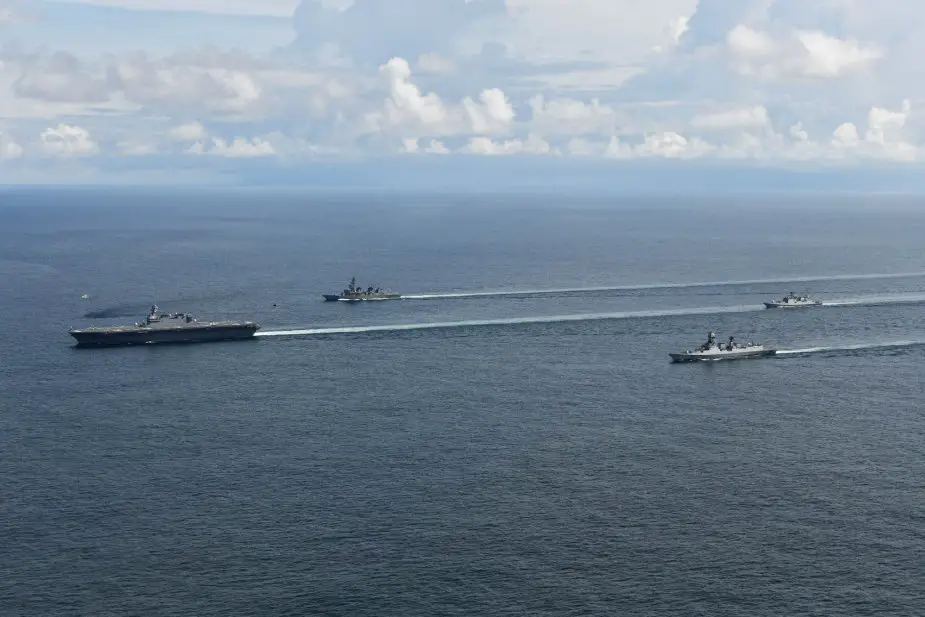Breaking news
Launch of MALABAR 2021 Phase II between Australia, India, Japan and US.
According to information published by the U.S. Navy on October 13, 2021, maritime forces from Australia, India, Japan, and the United States began Phase II of Exercise MALABAR 2021 in the Bay of Bengal.
Follow Navy Recognition on Google News at this link
 JMSDF's JS KAGA and JS MURASAME with Indian Navy's INS Kochi and INS Teg (Picture source: JMSDF)
JMSDF's JS KAGA and JS MURASAME with Indian Navy's INS Kochi and INS Teg (Picture source: JMSDF)
The U.S. Navy hosted this year’s annual maritime exercise which includes a variety of high-end tactical training, including specific interactions that are designed to enhance interoperability between the Royal Australian Navy (RAN), Indian Navy (IN), Japan Maritime Self Defense Force (JMSDF) and U.S. maritime forces.
The first phase of MALABAR, which began in August, included maritime operations, anti-submarine warfare operations, air warfare operations, live-fire gunnery events, replenishments-at-sea, cross-deck flight operations, and maritime interdiction operations in the Philippine Sea.
The current phase is being conducted in the Bay of Bengal. Planning and executing multinational exercises in two phases allows participating nations to operate and train in two different regions of the Indo-Pacific.
The second phase will consist of surface and air expendable mobile anti-submarine warfare training target exercise (EMATTEX), cross-deck helicopter operations, surface gunnery exercise, and replenishments at sea. The intent is to enhance integrated maritime operations between the Quad countries within the Indian Ocean Region.
Elements of the Royal Australian, Indian, Japanese, and American maritime forces routinely operate together in the Indo-Pacific, fostering a cooperative approach toward regional security and stability.
U.S. Navy participants for phase two included Carrier Strike Group (CSG) 1, consisting of the aircraft carrier USS Carl Vinson (CVN 70); Carrier Air Wing (CVW) 2; Ticonderoga-class guided-missile cruiser USS Lake Champlain (CG 57); Arleigh Burke-class guided-missile destroyer USS Stockdale (DDG 106); and a P-8A Poseidon maritime patrol and reconnaissance aircraft.
Representing the Indian Navy is Rajput-class guided-missile destroyer INS Ranvijay (D55), Shivalik-class multi-role stealth frigate INS Satpura (F48), and a P-8I maritime patrol and reconnaissance aircraft.
JMSDF participants included Izumo-class multipurpose operation destroyer JS Kaga (DDH 184), Murasame-class destroyers JS Murasame (DD 101).
Royal Australian Navy participants included Anzac-class frigate HMAS Ballarat (FFH 155) and HMAS Sirius (O 266).
JS Murasame is the lead vessel of the Murasame-class destroyers of the Japan Maritime Self-Defense Force (JMSDF).
The Murasame-class is a class of destroyers, in service with the Japan Maritime Self-Defense Force (JMSDF). This is the first class of the second-generation general-purpose destroyers of the JMSDF. The Murasame class destroyer is armed with an Mk48 VLS (vertical launching system) firing Sea Sparrow and Evolved Sea Sparrow surface-to-air missiles. The Mk41 VLS installed below the deck can fire RUM-139 VL ASROC (anti-submarine rockets). The ship is also armed with one OTO Melara 76 mm naval gun, two 20 mm Phalanx CIWS (Close-In Weapon Systems), and two triple 324mm torpedo tubes.
The Murasame class is powered by a combined gas turbine and gas turbine (COGAG) propulsion system. Two General Electric LM2500 boost gas turbines and two Rolls-Royce Sprey SM1C cruise gas turbines deliver a total power output of 60,000ps. The propulsion system provides a maximum speed of 30 knots and a range of 8,350 km at a cruising speed of 18 knots.





























